4 Patchin Place, E.E. Cummings Historical Marker
Introduction
Text-to-speech Audio
Images
Patchin Place (image from Historic Markers Database)
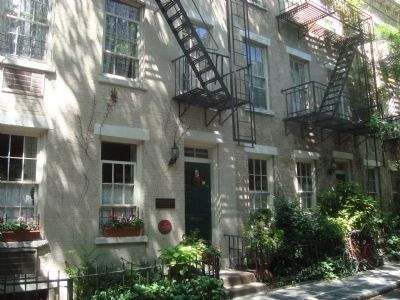
4 Patchin Place Historic Marker (image from Historic Markers Database)
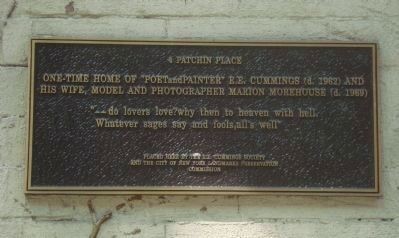
4 Patchin Place Marker for e.e. cummings (image from Historic Markers Database)
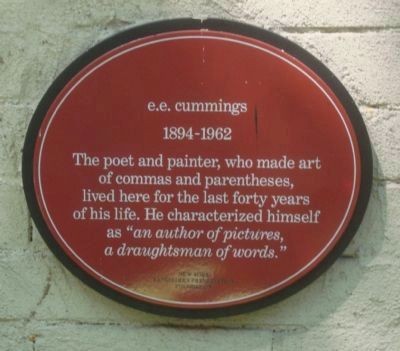
e.e. cummings (image from the Poetry Foundation)
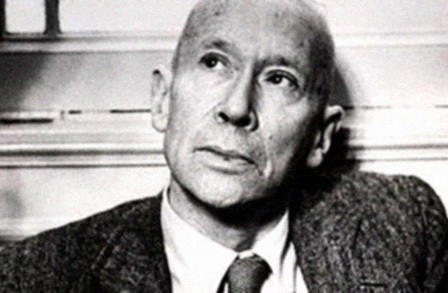
Patchin Place, 1910 (image from Book Club Mom Blog)
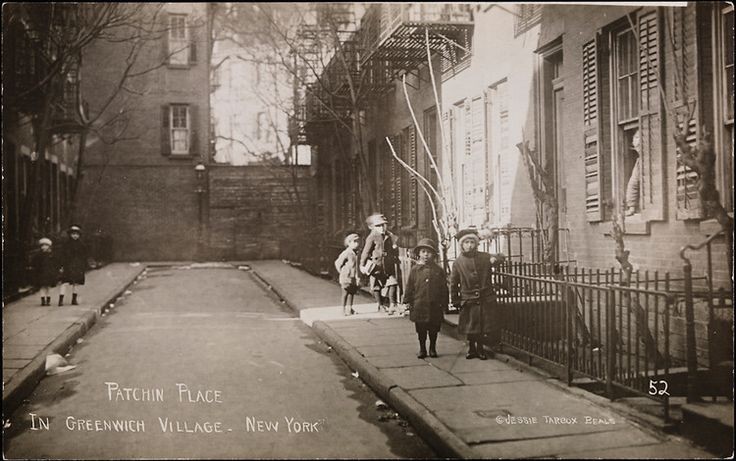
Vogue magazine portrait of Marion Morehouse, October 15, 1925 by Edward Steichen (image from the official Marion Morehouse website)
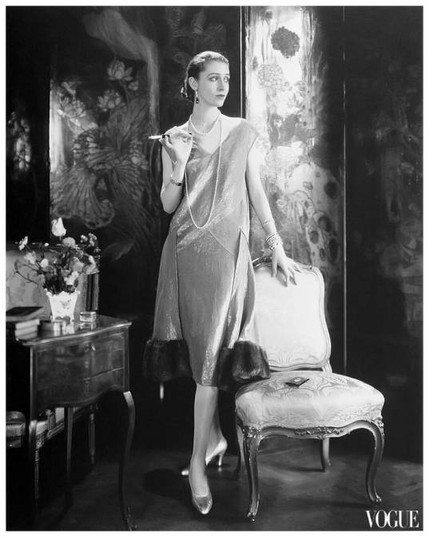
Djuna Barnes at the Patchin Place gate, photographed by Marion Morehouse in 1962 (image from Ephemeral New York)
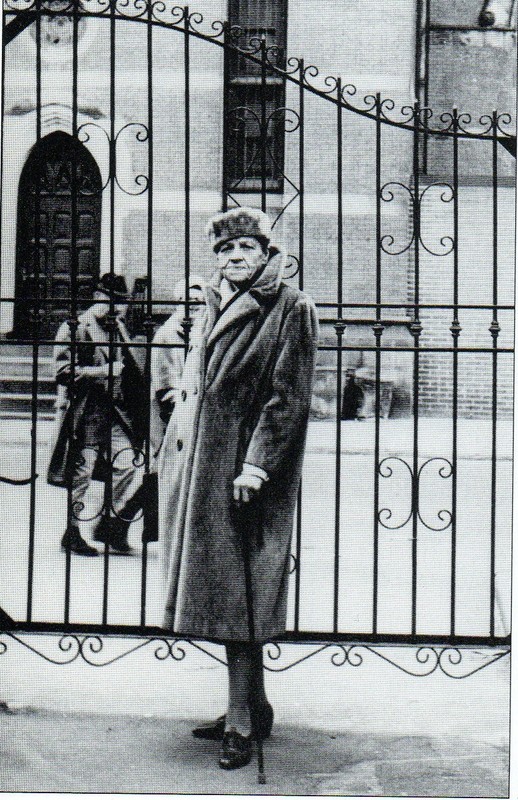
Backstory and Context
Text-to-speech Audio
The three-story houses of Patchin Place were constructed in the 1850s as living quarters for Basque waiters who worked nearby at the Brevoort Hotel. In the early twentieth century, electricity and running water were installed, and Patchin Place began to attract a new type of resident: actors, artists, and writers. On July 1, 1918, the residents even put on a production of Yeats' play, The King's Threshold in the communal backyard, with the orchestra playing through the window of one of the kitchens. Three hundred audience members attended, and the proceeds were donated to the Goodhue Home Fund of The Evening Post. Among Patchin Place's literary residents were poet E. E. Cmmings, his wife and fellow poet Marion Morehouse, and author Djuna Barnes, the couple's reclusive friend and next-door neighbor at #5 Patchin Place from 1940 on.
A Brief Biography of E. E.Cummingss, 1894-1962
Edward Estlin Cummings began writing poetry as a child, and produced a poem a day from age eight to age twenty-two. He attended Harvard University, where he transitioned from traditional poetic forms into the dynamic, avant-garde style he is known for: unconventional use of punctuation, syntax, and semantics in precise, spare poems. Some of his early poems were included in the Harvard Poetry Society's Eight Harvard Poets collection. The year after his graduation from Harvard, in April of 1917, Cummings volunteered in the Norton-Harjes Ambulance Service in France after the outbreak of the First World War in Europe, though the United States was not yet involved and Cummings considered himself a pacifist. On the French-German border, he befriended William Slater Brown, with whom he was arrested in September of 1917 on suspicion of treason. The two Americans were sent to an internment camp in Normandy; Cummings' father managed to secure his son's release in December, but Brown remained imprisoned until April 1918. The U.S. entered the war in July, and Cummings was drafted into the U.S. Army, training for six months in Massachusetts until relased in January of the following year. Cummings' daughter, Nancy, was born that December; Nancy's mother was Elaine Thayer, whose husband, Schofield, was a friend of Cummings and approved of his wife's relationship with him. Elaine divorced Schofield in 1924 to marry Cummings, who moved into 4 Patchin Place in September and adopted his daughter, Nancy Thayer. Not until 1948 did Nancy find out that her adoptive father was also her biological father. Only a year after Elaine and Cummings married, Elaine divorced her second husband upon meeting another man. In 1932, Cummings met Marion Morehouse, a Broadway actress and one of the most well-known fashion models of the late 1920s-early 1930s. Though Morehouse's obituary lists her as the "widow" of e. e. cummings, the two never actually married. Morehouse was born in 1903 in South Bend, Indiana, and kept many details of her life shrouded in mystery, even to e. e. cummings, her companion for thirty years.
Meanwhile, e. e. cummings had published his first book, The Enormous Room, in 1922. It was a fictional account of his imprisonment in France, and gained critical acclaim for its juxtapositon of a grim topic with a cheerful tone and emphasis on personal growth. In 1923, Cummings' first collection of poems, Tulips and Chimneys, was published, though with many poems cut and without Cummings' preferred form of the title (Tulips & Chimneys). The deleted poems were published two years later, in a volume entitled &. The same year, XLI Poems was published, and Cummings received Dial magazine's annual $2,000 award. His next collection, Is 5, was released the following year with an introduction explaining his approach to writing. With his own style established and critical acclaim for both the wonderment and the satire expressed in his works, e. e. cummings became one of the most popular poets of his time. He also wrote a play entitled Him (a series of skits which jumped from tragedy to grotesque comedy, influenced by the burlesque and the circus) and a travel diary entitled Eimi, which drew from Cummings' 1931 trip to the Soviet Union. The Soviet regime's strict regimentation and duhumanizing policies were the antithesis of Cummings' deep value of the individual, and Eimi (Greek for "I am") unabashedly attacked the dictatorship of Stalin. After Eimi was published in 1933, Cummings struggled to release his poetry through the left-wing publishers of the time, and self-published several volumes in the late 1930s. Harvard University invited e. e. cummings to give the Charles Eliot Norton lectures in poetry in 1952; these were later published as i: six nonlectures. The "nonlectures" consisted of personal accounts of Cummings' life and writing. Cummings died in 1962.
Historic Marker Inscriptions:
4 Patchin Place
One-time home of “Poet and Painter” e.e. cummings (d. 1962) and his wife, model and photographer Marion Morehouse (d.1969)
“—do lovers love? why then to heaven with hell. Whatever sages say and fools, all’s well”
Placed here by the e.e. cummings Society and the City of New York Landmarks Preservation Commission.
e.e. cummings
1894-1962
The poet and painter, who made art of commas and parentheses, lived here for the last forty years of his life. He characterized himself as “an author of pictures, a draughtsman of words.” New York Landmark Preservation Foundation.
Cite This Entry
Wolloch, Marc, Sara Marian, and Clio Admin. "4 Patchin Place, E.E. Cummings Historical Marker." Clio: Your Guide to History. June 18, 2018. Accessed March 18, 2025. https://theclio.com/tour/105/11/reverse

